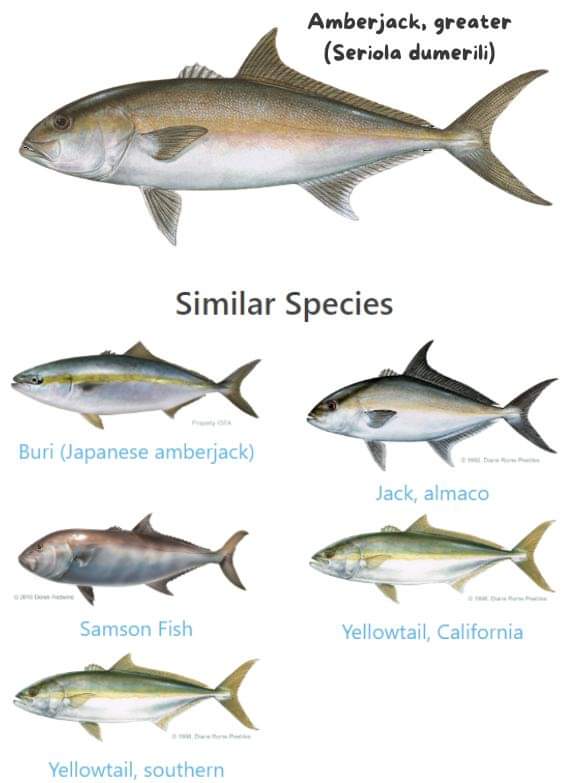**큰 황새치(Risso, 1810); CARANGIDAE FAMILY**
큰 황새치는 일본, 중국, 필리핀 주변 해역과 하와이 근처의 중부 태평양을 포함한 인도-태평양 지역에서 흔히 발견되는 종입니다. 또한 서부 대서양, 동부 대서양(특히 마데이라 주변과 아프리카 남부 및 서부 해안), 지중해 일부에 서식하며 열대 및 온대 수역에서 번성합니다. 주로 열린 수역 표면 근처에서 발견되지만, 해안 암초, 난파선, 부표 주변과 같은 상당한 깊이에서도 발견될 수 있습니다.
**신체적 특징**
이 물고기는 종종 주둥이에서 눈을 지나 등지느러미 시작 부분까지 이어지는 독특한 올리브색 막대로 식별됩니다. 넓은 호박색 줄무늬가 옆구리를 따라 수평으로 이어져 황새치 종과 혼동되는 경우가 많습니다. 그러나 큰 황새치는 아가미 갈퀴 수로 구별할 수 있습니다. 길이가 8인치가 넘는 황새치는 일반적으로 첫 번째 아가미 아치의 아랫부분에 11~16개의 아가미 갈퀴가 발달한 반면, 황새치는 21~28개입니다.
또한, 관련 종인 레인보우 러너는 등지느러미와 항문지느러미 뒤에 작고 분리된 지느러미가 있는데, 황새치에서는 없습니다. 큰 황새치와 작은 황새치는 아가미 갈퀴 수로 구별할 수도 있습니다. 작은 황새치는 23~26개, 큰 황새치는 11~19개입니다.
**스포츠 낚시와 행동**
황새치과에서 가장 큰 종인 큰 황새치는 공격적인 성격 때문에 스포츠 어부들에게 매우 귀중하게 여겨집니다. 빠르게 공격하고, 격렬하게 싸우며, 종종 바닥으로 다이빙하는 것으로 알려져 있어 잡기가 까다롭습니다. 흥미롭게도, 황새치 한 마리가 낚싯바늘에 걸려 수면으로 올라오면 다른 황새치들이 종종 따라잡습니다. 인기 있는 낚시 기술로는 미끼, 스푼, 플러그, 지그 또는 스트립 미끼를 사용하여 수면 근처에서 트롤링하는 것과 살아있는 미끼 낚시가 있습니다. 많은 우연한 어획은 낚시꾼이 도미와 그루퍼와 같은 바닥에 사는 종을 겨냥하는 동안 발생합니다.
**시과테라 중독**
게임 물고기로 인기가 있음에도 불구하고, 큰 황새치는 오염된 산호초 물고기를 섭취하는 것과 관련된 심각한 식품 매개 질병인 시과테라 중독을 일으킨 것으로 의심되는 300종 이상의 열대어 종 중 하나입니다.
📷 출처: igfa,org

**Greater Amberjack (Risso, 1810); CARANGIDAE FAMILY**
The Greater Amberjack is a species commonly found in the Indo-Pacific region, including waters around Japan, China, and the Philippines, as well as in the central Pacific near Hawaii. It also inhabits parts of the western Atlantic Ocean, eastern Atlantic (specifically around Madeira and the southern and western coasts of Africa), and the Mediterranean Sea, thriving in tropical and warm temperate waters. While primarily found near the surface of open waters, the species can also be encountered at considerable depths, around offshore reefs, wrecks, and buoys.
**Physical Characteristics**
This fish is often recognized by a distinctive olive-colored bar that runs from its snout, through the eye, and extends to the beginning of the dorsal fin. A broad amber-colored stripe runs horizontally along its flanks, leading to frequent confusion with yellowtail species. However, greater amberjacks can be differentiated by their gill raker count: those over 8 inches long typically have 11 to 16 developed gill rakers on the lower limb of the first branchial arch, compared to yellowtails, which have between 21 and 28.
Additionally, the rainbow runner, a related species, features small, separate finlets behind its dorsal and anal fins, which are absent in amberjacks. The greater and lesser amberjacks can also be distinguished by their gill raker count—lesser amberjacks have 23-26, while greater amberjacks have 11-19.
**Sport Fishing and Behavior**
As the largest member of the jack family, the greater amberjack is highly prized by sport fishermen due to its aggressive nature. Known for striking quickly, fighting hard, and often diving towards the bottom, it is a challenging catch. Interestingly, when one amberjack is hooked and brought to the surface, others often follow it up. Popular fishing techniques include trolling near the surface with lures, spoons, plugs, jigs, or strip baits, as well as live bait fishing. Many incidental catches occur while anglers are targeting bottom-dwelling species like snappers and groupers.
**Ciguatera Poisoning**
Despite its popularity as a game fish, the greater amberjack is among over 300 species of tropical marine fish suspected of causing ciguatera poisoning, a serious foodborne illness associated with consuming contaminated reef fish.
📷 Credit : igfa,org
'♥몬스터피쉬 동호회' 카테고리의 다른 글
| 몬스터 피셔맨의 기본 준비자세~!!! (0) | 2024.10.17 |
|---|---|
| 태국의 전형적인 낚시배 형태 (0) | 2024.10.17 |
| 시밀란 낚시배. 082-6259009 (0) | 2024.10.16 |
| 동탄비치에서 오징어 낚시중 ^&^ (0) | 2024.10.13 |
| 태국에서 사용하는 오징어 낚시 미끼 즉 에깅은 크기가 작다 (0) | 2024.10.10 |



